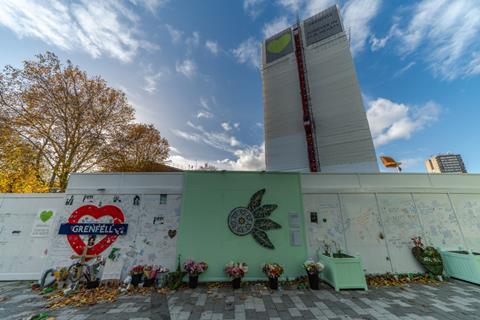Next phase will examine why materials in fatal blaze failed to meet Building Regulations, says inquiry head

The first long-awaited Grenfell Tower Inquiry report has pointed the finger of blame for the spread of the fire at ACM cladding and effectively backed Judith Hackitt’s call for a “golden thread” of information around a building’s construction.
Written by former judge Martin Moore-Bick, the report has called for owners and managers of high-rise residential blocks to be required by law to provide local fire and rescue services with up-to-date plans of every such building.
Plans should be lodged in both paper and electronic form, the report said, while plans should also be kept in a “premises information box” which would be accessible by the fire brigade in the event of emergency personnel needing to use them.
The recommendations were contained in the initial 856-page report into the response of the rescue services to the fire on June 14, 2017, which killed 72 people.
The report said: “A sound understanding of the materials used in the construction of any high-rise building is essential if the fire and rescue service is to be properly prepared to carry out its function in relation to that building.
“The risk of fire of the kind that occurred at Grenfell Tower may be low, but knowledge is the key to proper planning and effective training.”
Other recommendations included requiring owners and managers of every residential building containing separate dwellings, whether or not they are high-rise, “to carry out an urgent inspection of all fire doors to ensure that they comply with applicable legislative standards”.
As widely leaked, the report said the fire spread as quickly as it did because of the presence of ACM cladding with polyethylene cores, “which acted as a source of fuel”.
Moore-Bick said there was “compelling evidence” that the external walls of the building failed to comply with Requirement B4(1) of Schedule 1 to the Building Regulations 2010, “in that they did not adequately resist the spread of fire having regard to the height, use and position of the building. On the contrary, they actively promoted it.”
Moore-Bick said the second phase of the inquiry, due to start early next year, “must examine why those who were responsible for the design of the refurbishment considered that the tower would meet that essential requirement”.
Speaking as the report was published, the Local Government Association’s building safety spokesman Gary Porter said: “There are undoubtedly lessons that can be learnt about how the fire service responded on that tragic night as it faced the worst fire in this country for more than half a century.
“However, the inquiry has made a fundamental error by examining the response to the fire before examining its causes. The consequence of this is to scapegoat the fire service while those responsible for the fire have yet to be exposed or held to account.”
Porter said it was clear that the fire had been caused “by a catastrophic failure of the building safety system in England. Reform of this broken system cannot come soon enough.”
Moore-Bick said phase two of the inquiry would look at how the 72 residents died and the regime that allowed the tower to be built in the way it was.
Matters of “particular concern” for that phase of his inquiry include:
- The decisions relating to the design of the refurbishment and the choice of materials
- The regime for testing and certifying the reaction to fire of materials intended for use in construction
- The design and choice of materials
- The performance of fire doors in the tower, in particular whether they complied with relevant regulations, their maintenance and the reasons why some of the self-closing devices do not appear to have worked
- The organisation and management of the London Fire Brigade, in particular in relation to the formulation of policy in the light of experience, the arrangements for training firefighters and control room staff, and the arrangements for sharing information about the particular problems associated with fighting fires in high-rise buildings
- The warnings of potential fire hazards given by the local community
- The authorities’ response to the disaster.
















No comments yet